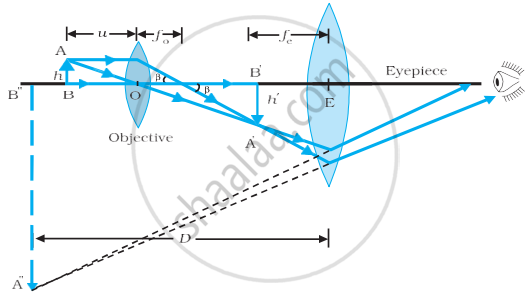Advertisements
Advertisements
प्रश्न
Draw a ray diagram of compound microscope for the final image formed at least distance of distinct vision?
उत्तर
Diagram of Compound Microscope for the final image formed at D:
APPEARS IN
संबंधित प्रश्न
The total magnification produced by a compound microscope is 20. The magnification produced by the eye piece is 5. The microscope is focussed on a certain object. The distance between the objective and eyepiece is observed to be 14 cm. If least distance of distinct vision is 20 cm, calculate the focal length of the objective and the eye piece.
When viewing through a compound microscope, our eyes should be positioned not on the eyepiece but a short distance away from it for best viewing. Why? How much should be that short distance between the eye and eyepiece?
How can the resolving power of a compound microscope be increased? Use relevant formula to support your answer.
In which of the following the final image is erect?
(a) Simple microscope
(b) Compound microscope
(c) Astronomical telescope
(d) Galilean telescope
A compound microscope forms an inverted image of an object. In which of the following cases it it likely to create difficulties?
A convex lens of a focal length 5 cm is used as a simple microscope. Where should an object be placed so that the image formed by it lies at the least distance of distinct vision (D = 25 cm)?
How does the resolving power of a microscope change when
(i) the diameter of the objective lens is decreased?
(ii) the wavelength of the incident light is increased ?
Justify your answer in each case.
An angular magnification of 30X is desired using an objective of focal length 1.25 cm and an eye piece of focal length 5 cm. How will you set up the compound microscope for the final image formed at least distance of distinct vision?
| A compound microscope consists of two converging lenses. One of them, of smaller aperture and smaller focal length, is called objective and the other of slightly larger aperture and slightly larger focal length is called eye-piece. Both lenses are fitted in a tube with an arrangement to vary the distance between them. A tiny object is placed in front of the objective at a distance slightly greater than its focal length. The objective produces the image of the object which acts as an object for the eye-piece. The eye-piece, in turn, produces the final magnified image. |
In a compound microscope, the images formed by the objective and the eye-piece are respectively.
The focal lengths of the objective and the eye-piece of a compound microscope are 1.0 cm and 2.5 cm respectively. Find the tube length of the microscope for obtaining a magnification of 300.
